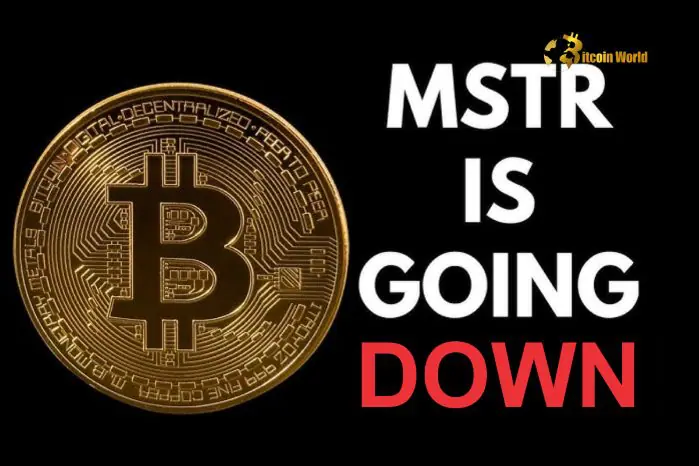Hold onto your hats, crypto enthusiasts! The MicroStrategy saga, a cornerstone of Bitcoin institutional adoption, just took an interesting turn. Remember when MicroStrategy’s stock was trading at a massive premium because of its Bitcoin holdings? Well, that premium has shrunk significantly, and crypto analyst Miles Deutscher is shedding light on what this could mean. Let’s dive into the details of this developing story and explore the potential ripple effects across the crypto market.
Decoding the Bitcoin NAV Premium: What’s the Buzz About?
First things first, let’s break down this term ‘Bitcoin NAV Premium‘. NAV stands for Net Asset Value. In MicroStrategy’s case, their primary asset, besides their actual business, is a massive hoard of Bitcoin. The NAV premium is essentially the ratio of MicroStrategy’s market capitalization (the total value of its outstanding shares) to the actual value of the Bitcoin they hold.
Think of it like this: if MicroStrategy only held Bitcoin and nothing else, and the market valued the company exactly at the value of its Bitcoin, the NAV premium would be 1. However, for a long time, MicroStrategy traded at a premium *above* the value of its Bitcoin. This premium reflected several factors:
- Investor Sentiment: Many investors viewed MicroStrategy as a publicly traded proxy for Bitcoin exposure, especially before the advent of spot Bitcoin ETFs in the US. For those unable or unwilling to hold Bitcoin directly, MicroStrategy stock offered a way to gain exposure to Bitcoin’s price movements within a traditional stock market framework.
- Michael Saylor Effect: The strong pro-Bitcoin stance and aggressive acquisition strategy of MicroStrategy’s former CEO, Michael Saylor, cultivated a loyal investor base who believed in his vision and Bitcoin’s long-term potential. This ‘Saylor premium’ contributed to the elevated stock price.
- Scarcity and Demand: For a period, publicly listed companies holding significant Bitcoin were relatively rare. This scarcity, coupled with investor demand for Bitcoin exposure, further inflated MicroStrategy’s premium.
In essence, the Bitcoin NAV Premium was a measure of how much extra investors were willing to pay for MicroStrategy shares beyond the intrinsic value of their Bitcoin holdings. A high premium signaled strong bullish sentiment and demand for indirect Bitcoin exposure.
The Plummeting Premium: From a Hefty 3.4 to a Modest 1.6
Now, here’s the crucial development. According to crypto analyst Miles Deutscher, as highlighted on X, MicroStrategy’s Bitcoin NAV Premium has experienced a significant decline. It has shrunk from a peak of 3.4 in November 2024 to approximately 1.6. That’s a dramatic decrease! To put it in perspective:
| Metric | November 2024 | Current (as per Deutscher’s report) |
|---|---|---|
| Bitcoin NAV Premium | 3.4 | 1.6 |
This sharp drop indicates a substantial shift in market perception and potentially investor appetite for MicroStrategy as a Bitcoin proxy. The ‘extra’ value investors were assigning to MicroStrategy beyond its Bitcoin holdings has significantly diminished.
Crypto Analyst Miles Deutscher’s Insight: Decoding the Implications
So, why does this matter, and what are the potential consequences? Crypto analyst Miles Deutscher offers a key insight: a lower Bitcoin NAV Premium could make it more challenging for MicroStrategy to raise capital for future BTC acquisitions. Let’s unpack this:
- Capital Raising Mechanism: MicroStrategy has historically funded its aggressive BTC acquisitions through various methods, including issuing debt and selling equity (stock). A significant part of the attractiveness of issuing equity was the high NAV premium.
- Dilution and Premium: When a company issues new shares, it dilutes existing shareholders’ ownership. However, if the company’s stock trades at a substantial premium, it can issue fewer shares to raise the same amount of capital. A high premium effectively made it cheaper for MicroStrategy to raise funds.
- Lower Premium, Higher Cost of Capital: With a reduced Bitcoin NAV Premium, MicroStrategy would need to issue more shares to raise the same amount of capital. This increases dilution for existing shareholders and makes capital raising less efficient and potentially less appealing.
In essence, the shrinking premium could constrain MicroStrategy’s ability to continue its rapid accumulation of Bitcoin at the same pace as before. It raises questions about their future BTC acquisitions strategy and financial maneuvering.
BTC Acquisitions and MicroStrategy’s Future: What’s Next?
Does this mean MicroStrategy’s Bitcoin buying spree is over? Not necessarily, but it might need to adapt its approach. Here are some potential scenarios and considerations regarding future BTC acquisitions:
Challenges:
- Reduced Capital Raising Power: As discussed, a lower premium makes equity-based capital raises less attractive and more dilutive. MicroStrategy might need to explore alternative funding sources or accept a slower pace of Bitcoin accumulation.
- Market Sentiment Shift: The premium drop could reflect a broader shift in market sentiment towards Bitcoin proxies, especially with the availability of spot Bitcoin ETFs. Investors now have more direct and potentially lower-cost avenues for Bitcoin exposure.
- Increased Scrutiny: A shrinking premium might lead to increased scrutiny from investors and analysts regarding MicroStrategy’s business model and reliance on Bitcoin price appreciation.
Potential Adaptations and Opportunities:
- Focus on Operational Profitability: MicroStrategy could emphasize its core software business and demonstrate profitability beyond just Bitcoin holdings. This could make the company more attractive to a broader range of investors, even with a lower NAV premium.
- Alternative Funding: Explore debt financing, strategic partnerships, or other creative financial instruments to fund future BTC acquisitions, reducing reliance on equity issuance at potentially lower premiums.
- Long-Term Bitcoin Strategy: Reiterate and reinforce its long-term commitment to Bitcoin as a treasury reserve asset. Emphasize the potential for future premium expansion as Bitcoin adoption grows and matures.
- Spot Bitcoin ETF Competition: While ETFs offer direct Bitcoin exposure, MicroStrategy still offers a unique publicly traded equity with significant Bitcoin holdings and a distinct corporate strategy. They might need to differentiate their value proposition in the ETF era.
Is This a Cause for Alarm or a Market Correction?
The decrease in MicroStrategy’s Bitcoin NAV Premium is undoubtedly a significant development. Whether it’s a cause for alarm or a healthy market correction is a matter of perspective and future developments. Here’s a balanced view:
Potential Concerns:
- Reduced Buying Power: If the lower premium persists, it could genuinely limit MicroStrategy’s capacity for future aggressive Bitcoin purchases, which some viewed as a positive catalyst for Bitcoin adoption.
- Shifting Narrative: The narrative around MicroStrategy as *the* premier publicly traded Bitcoin proxy might weaken, potentially impacting investor sentiment and stock performance.
Potential Positives and Perspective:
- Normalization of Valuation: A premium of 3.4 might have been considered unsustainably high. A drop to 1.6 could represent a more rational and sustainable valuation, aligning MicroStrategy’s stock price more closely with its underlying Bitcoin assets.
- Focus on Fundamentals: A lower premium might force MicroStrategy to focus more on its core business fundamentals and less on solely relying on Bitcoin price appreciation to drive stock value. This could be a positive long-term development.
- Market Evolution: The emergence of spot Bitcoin ETFs has fundamentally changed the landscape for Bitcoin investment. The reduced premium could simply reflect the market adapting to these new realities and more efficient avenues for Bitcoin exposure.
Concluding Thoughts: Navigating the Evolving MicroStrategy and Bitcoin Landscape
MicroStrategy’s shrinking Bitcoin NAV Premium is a compelling case study in the evolving dynamics of the crypto market and the intersection of traditional finance and digital assets. While it presents potential challenges for their aggressive Bitcoin accumulation strategy, it also opens doors for strategic adaptation and a potentially more sustainable long-term business model. The insights from crypto analyst Miles Deutscher highlight the importance of understanding these nuanced market signals. As the crypto landscape matures and diversifies, companies like MicroStrategy will need to navigate these shifts strategically to maintain their position and continue to contribute to the broader Bitcoin ecosystem.
To learn more about the latest crypto market trends, explore our article on key developments shaping Bitcoin institutional adoption.
Disclaimer: The information provided is not trading advice, Bitcoinworld.co.in holds no liability for any investments made based on the information provided on this page. We strongly recommend independent research and/or consultation with a qualified professional before making any investment decisions.


